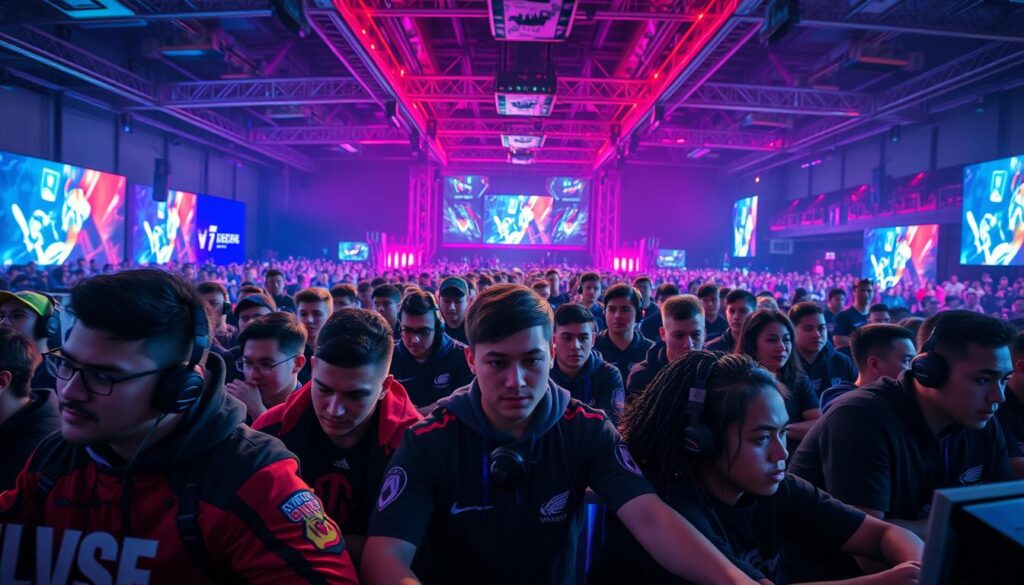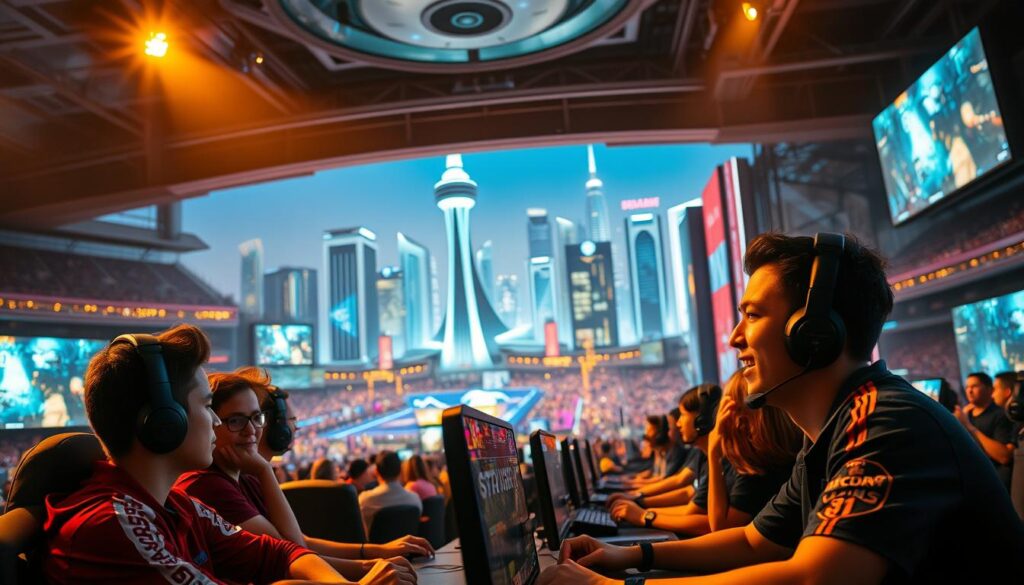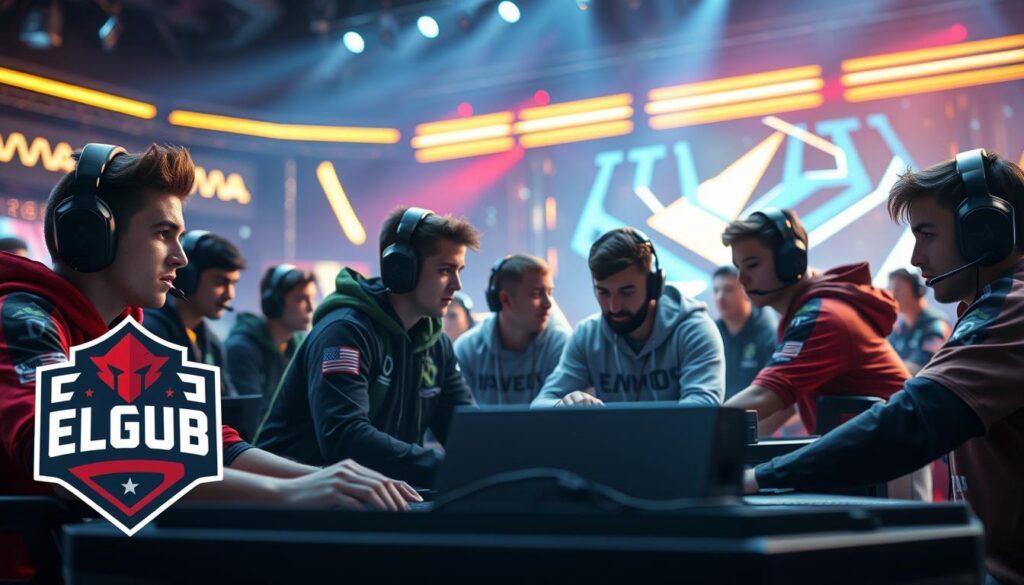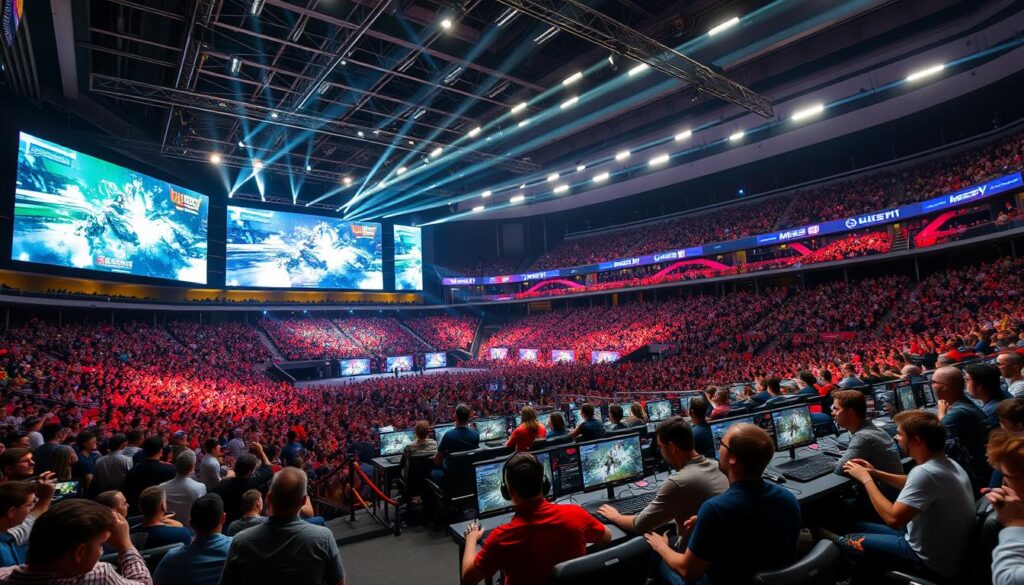Imagine 16th-century Florence, but instead of philosophers debating, it’s teenagers trash-talking in Discord servers. Today’s digital colosseums are filled with Gen Z gamers, not gladiators. A Call of Duty killstreak excites them more than a touchdown pass. We’ve traded quills for Quick Scopes, and it’s a cultural renaissance like no other.
Steam’s 2023 data shows 120 million monthly active users, about 38% of America’s population. This isn’t just a player base; it’s a parallel society. Friday night lights now shine from RGB keyboards. Family debates over Warzone strategies have replaced Thanksgiving dinner arguments about Joe Montana.
This isn’t just entertainment. It’s a societal red pill moment. Competitive gaming’s $1.8 billion ecosystem has changed fandom, mentorship, and regional pride. Why cheer for your hometown team when you can wear FaZe Clan’s merch?
The magic lies in how headshot highlights have become this generation’s watercooler conversations. We’ve moved from swordfights to strategic loadouts. It shows humanity’s competitive spirit is alive and well, with a respawn button.
Defining Gaming Culture
Gaming culture has grown a lot. It has taken over our everyday lives like a powerful AI. What started as simple arcade games now shapes how we interact and celebrate. It’s turned “pwned” into a form of poetry and made loot boxes a topic for dinner.
From Pixels to Pantheons
In 1980, the World Video Game Championship had just two games and a small crowd. By 2023, Fortnite’s virtual concert drew 12 million viewers. That’s like filling six Madison Square Gardens with people doing the Floss.
Twitch’s 31 million daily viewers are more than just watching. They’re part of social gaming rituals, mixing sports with talk shows. Here are some key changes:
- Arcade cabinets → Digital arenas for big esports tournaments
- High score initials → Twitch streamer merch empires
- “Game Over” screens → Long stories in RPGs
The Language of Headshots
Gamer slang has entered our workplaces and social media. When HR talks about “Let’s circle back post-respawn,” we know gaming culture is everywhere. The shift in language shows how deep gaming has become:
| 1980s | 2020s | Cultural Impact |
|---|---|---|
| “Insert Coin” | “Drop In” | From pay-to-play to free-to-own ecosystems |
| “Extra Life” | “Hard Carry” | Individualism vs team-based social gaming |
| “High Score” | “K/D Ratio” | Quantified self-optimization meets streaming clout |
This change in language isn’t random. As psychologist Dr. Rachel Kowert says:
“Gaming vernacular provides shared context for a generation that communicates through references as much as words.”
In other words, “Git gud” is like saying “Carpe diem” but with better aim.
Esports in the Social Fabric
Move over, Monday Night Football – there’s a new colosseum in town, and it’s powered by fiber-optic cables. The esports culture has grown from basement LAN parties to filling Seoul’s 20,000-seat Gocheok Sky Dome. But here’s the twist: The real action isn’t just in physical arenas. It’s happening wherever someone’s got a screen, a mouse, and enough Mountain Dew to fuel a 12-hour stream.
Stadiums vs Servers
Riot Games sold out Madison Square Garden for its 2016 League of Legends finals faster than Taylor Swift tickets. But here’s where gaming trends flip the script: For every fan in the seats, there are 50 more watching via Twitch with chat moving faster than a pro’s APM (actions per minute, for the uninitiated). The social experience? It’s less about foam fingers and more about spamming emotes when someone pulls off a pentakill.
Let’s talk numbers that’ll make Wall Street sweat. When TSM – basically the New York Yankees of League of Legends – scored a $410M valuation, it wasn’t just about jersey sales. The esports economy runs on:
- Sponsorships slicker than a CS:GO knife skin (Red Bull’s training complex has more biometric sensors than NASA)
- Media rights deals where Amazon pays $1B just to stream tournaments
- Merch drops that sell out faster than concert tickets for virtual K-pop groups
| Metric | Esports (2023) | Traditional Sports |
|---|---|---|
| Global Revenue | $1.38B | NFL: $18B |
| Youngest Fan Base | 72% under 35 | MLB: 50% over 45 |
| Training Tech | Neural response trackers | Wind sprints & weight racks |
Here’s the kicker: The 2021 International Dota 2 Championship had a $40M prize pool. That’s more than the Masters, Kentucky Derby, and Daytona 500 combined. Suddenly, practicing 14 hours/day doesn’t seem so crazy when you’re training to be a millionaire digital gladiator.
How Gamers Connect and Compete
Today, people bond over gaming, not just bridge clubs or casserole recipes. The gaming community is a place where friends work together and compete. It’s like a mix of teamwork and rivalry, all wrapped up in a virtual package.

Discord: The New Town Square
Discord has 150 million users every month. They’re not just talking; they’re building their own worlds. From small Valorant teams to huge Minecraft cities, these communities are real. A study found 68% of gamers see their online friends as real buddies.
Leaderboard Anthropology
Leaderboards show more than just who’s good at games. They show who’s at the top of the social ladder. Here’s what it’s all about:
| Social Structure | Traditional Clubs | Digital Clans |
|---|---|---|
| Membership Criteria | Geographic proximity | K/D ratio compatibility |
| Status Symbols | Lion’s Club lapel pins | Legendary weapon skins |
| Meeting Places | VFW Hall Room 3B | Custom COD: Warzone maps |
It’s all about balance between working together and competing. You might protect your Rainbow Six Siege teammate, but also celebrate their defeat. This balance makes friendships stronger than any community event.
Today’s social gaming is more than just fun. It’s building a new kind of society. When kids can organize huge Fortnite tournaments, we need to rethink what community means.
Esports and Youth Identity
Gamer tags now mean more than middle names. A Texas teen might say, “Platinum-ranked Jett main” instead of their GPA. This shows how identity is changing for the digital age.
Avatars as Authentic Selves
Today, gamers aren’t just picking characters. They’re curating digital extensions of their ideal selves. A 2023 PlayVS study found 63% of high school gamers feel more real in-game than in school.
Why? Your Valorant avatar never gets benched for bad grades.
Take 17-year-old ‘NeonDash’, who makes $120k/year streaming CS:GO. “My viewers know the real me,” he told ESPN Esports. “School feels like loading screen time now.”
Career Paths: From Ranks to Paychecks
Esports has changed the career ladder. PlayVS says 22% of college League players have agents before they graduate. Here’s how the new scoreboard looks:
| Career Metric | Esports Pro | Traditional Athlete | Key Difference |
|---|---|---|---|
| Peak Earnings Age | 17-21 | 27-31 | 6-year head start |
| Pathway Cost | $60 (gaming rig) | $60k (travel teams) | 1000x cheaper entry |
| Brand Deals | Twitch/Red Bull | Nike/Gatorade | Digital vs physical |
This isn’t just about money—it’s about cultural value. When Gen Z talks about Faker’s LOL legacy versus Jordan’s rings, they’re redefining excellence. The battle is fought on Discord servers, not just in games.
Esports as a Lifestyle
What happens when your gaming chair becomes a status symbol? Welcome to the era where esports culture isn’t just about gameplay – it’s a full-spectrum identity play. The esports lifestyle evolution has transformed RGB lighting into the new neon underglow, and team jerseys into business casual attire.
Jerseys Over Suits
NBA executives might want to check the receipts: 100 Thieves’ limited-edition hoodies regularly sell out faster than Lakers merchandise. This isn’t just merch – it’s wearable cred. The gaming community has turned team logos into tribal markings, with FaZe Clan’s streetwear collabs functioning like Supreme drops for the Fortnite generation.
Corporate America has taken notice. Wall Street brokers now rock TSM snapbacks alongside their Rolexes. Why? Because knowing League of Legends pick rates signals cultural fluency better than an Ivy League degree. The battlestation has become this generation’s power desk – complete with G FUEL shakers where crystal decanters used to sit.
Energy Drinks: The New Pre-Game Meal
Forget protein shakes. The true fuel of modern competition comes in neon cans with 300mg of caffeine. Gaming’s caffeine economy tells us everything:
- Prime Hydration (co-founded by Logan Paul) outsold Gatorade in 7-Elevens last quarter
- Red Bull’s gaming division now sponsors more players than their F1 team
- Twitch streams feature branded drink coolers more prominently than webcams
This isn’t just about staying awake – it’s ritualistic. Crackling open a Monster before ranked matches has become the new pre-game prayer. The can’s design matters as much as the contents, with limited-edition flavors serving as collectible trophies.
As esports infiltrates mainstream culture, its gaming community keeps rewriting the rules. Your jersey isn’t just clothing – it’s armor. Your energy drink isn’t just caffeine – it’s communion wine. And your gaming setup? That’s the new corner office.
Fan Communities and Online Forums
Forget town halls and coffee shops – today’s social hubs are online. Gaming communities have become digital nations. They have their own languages, cultural symbols, and hierarchy systems.
Memes are like coats of arms in the TikTok world. They show who you are in a funny way.

Memes as Heraldry
Why use a family crest when you can use “PogChamp” in chat? Modern gaming clans use symbols like Fortnite’s Orange Justice dance. These symbols are like:
- Social currency in Discord servers
- Instant mood indicators during streams
- Secret handshakes for community insiders
Twitch’s “Sit” emote is like dropping the mic. It’s a 21st-century way to say “Et tu, Brute?” – a mix of celebration and psychological warfare.
The Art of the Copypasta
Copy-paste humor might seem simple but it’s powerful. Phrases like “What’s a computer?” from Apple’s ad show how social gaming communities:
“Turn corporate mistakes into jokes that last longer than the games”
Reddit’s r/Competitiveoverwatch is a great example. It’s like a class where people dissect game mechanics. Building global gaming fan communities happens through laughter at memes. It’s like passing notes in class – but those notes can crash Discord servers.
Cultural Impact of Esports
When Street Fighter V tournaments air on ESPN2 and colleges recruit esports athletes, it’s a big deal. It shows how competitive gaming has become a part of everyday life. It’s not just a trend; it’s a full-on takeover.
Mainstreaming the Meta
Esports has made gaming terms popular worldwide. You might see “GG” and “nerf this” in Super Bowl ads. Twitch streamers even get more viewers than CNN.
Here are some signs of esports’ growing influence:
- Nielsen’s 2023 report shows 72% of millennials follow esports—double the engagement of Gen X with golf
- University of California campuses now offer scholarships for Overwatch players
- Fortnite World Cup winners get interviewed on Good Morning America
From Niche to Nielsen Ratings
Gaming has made a big splash in traditional media. As one Nielsen analyst said:
“We used to track soap operas and sitcoms. Now we’re calculating peak concurrent viewers for League of Legends Worlds—and explaining what ‘mid-lane diff’ means to executives.”
This change is huge, not just in numbers. It’s changing how we see the world. Kids who used to get in trouble for gaming now get big sponsorships. Brands are trying to connect with gamers, even if they don’t get it.
The impact is huge. Esports isn’t just part of the mainstream; it’s leading the way. Traditional sports and Hollywood are trying to keep up. The message is clear: you must adapt or you’ll be left behind.
The Future of Gaming Culture
Remember when Ready Player One felt like dystopian fiction? Turns out we’ve been reading the instruction manual. Epic Games is quietly turning Fortnite into a metaverse. It’s a place where reality gets remodeled.
VR Lobbies: Where Handshakes Meet Headset Adjustments
The Zoom-fatigued masses will soon ditch grid views for virtual campfires. Imagine:
- Startup pitches happening on floating islands
- Job interviews conducted through cooperative boss battles
- First dates where your avatar’s fashion sense matters more than your resume
Discord’s current 196 million users? Those are beta testers for the spatial computing revolution.
Holographic HUDs: Your Eyeballs’ New Best Friend
Why stare at screens when victory conditions can float beside your coffee mug? Microsoft’s leaked HoloLens 3 prototypes suggest:
- Real-time strategy overlays on tabletops
- Health bars hovering over your Peloton
- Speedrun tutorials projected onto bathroom mirrors
It’s Tony Stark meets Twitch streamer – and your living room becomes the ultimate augmented reality interface.
Blockchain Scoreboards: Flexing Where It Counts
The future of bragging rights lives on-chain. Picture:
- NFT trophy cases verifying your 2005 Halo 2 rankings
- Smart contracts paying out for speedrun world records
- DAO-governed tournaments where fans vote on rule changes
Axie Infinity’s play-to-earn model was just the tutorial level. Next up: your grandkids inheriting digital collectibles through crypto wallets.
As gaming absorbs social media, education, and even dating apps, one truth emerges: The “gaming community” will soon just be called “society.” Better practice your headset hair routine.
Conclusion
Gaming culture has grown from small LAN parties to huge events in Seoul. It has become a key part of who we are. Esports is now a big part of what young people talk about, even more than TikTok.
When Fortnite concerts get more viewers than Coachella, it shows how big esports has become. League of Legends games even get more viewers than NBA finals. This change is already part of our everyday lives.
This isn’t just about being a fan. It’s about belonging to a community. Twitch streams are like virtual campfires where millions meet. Discord servers are like secret clubs that shape our social world.
Watching The International’s Dota 2 tournament is like watching a huge event. It even beats Wimbledon in prize money. Dr Disrespect’s streaming is so popular, it’s like he’s a superstar.
Rock ‘n’ roll had its own symbols like leather jackets. Now, gaming has its own, like RGB-lit setups and high-definition streams.
Is Ninja the new Jimi Hendrix? Is the LCS arena like Woodstock? The numbers say yes. There are 3 billion gamers worldwide, and Gen Z spends more time in Roblox than in school.
Traditional sports are now copying esports. They even have virtual races and esports leagues. Memes spread faster than news, and your gaming skills are more important than your job title.
Gaming culture didn’t need permission to grow. Esports is already changing how we compete and connect. The gaming generation isn’t waiting for old institutions to catch up. They’re creating their own future.




